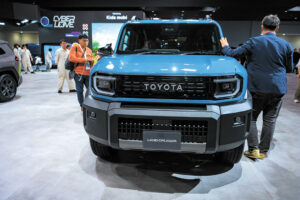IT WAS QUITE a difficult ask to get a clean shot of one of the most popular attractions at the Toyota pavilion of the Japan Mobility Show 2025. During the two press days we were at the Tokyo Big Sight — indoors and away from the nippy cold starting to pull down the mercury in this part of the world — there always seemed to be someone waiting for his or her turn to get a selfie, or to create a video spiel, in front of the vehicle on the floor.
The vehicle in question? The so-called Toyota Land Cruiser FJ — an obvious combo of two memorable, hallowed nameplates: the Land Cruiser and FJ Cruiser.
According to Toyota, the Land Cruiser was first launched as the Toyota BJ in 1951, and promptly built up its cred as the first vehicle to “climb to the sixth station of Mount Fuji,” an obviously impressive feat. “Since then, it has fulfilled its mission of delivering safety and security to all types of people in places that only the Land Cruiser can reach. Developed and refined based on global, real-world customer usage… (it) allows people to go anywhere and everywhere, and return safely,” continued the company in a release.
The success of the Land Cruiser (or, simply, LC) cannot be denied. Per Toyota, cumulative sales of the LC (including platform siblings Lexus LX and GX) have reached about 12.15 million units in over 190 countries and regions worldwide as of the end of August this year.
With the Land Cruiser FJ, Toyota grows the LC lineup from its original “three distinct series,” the Station Wagon (currently the 300 Series); the so-called Heavy-Duty model (currently the 70 Series); and the “core” Land Cruiser model rolled out in 2024 “as a return to the car’s origins — a simple, sturdy vehicle that helps fulfill customers’ lifestyle choices and practical needs (the 250 Series).”
So, what does the Land Cruiser FJ (FJ means “freedom and joy,” by the way) bring to the table? Toyota said it’s about “enjoying the Land Cruiser (in one’s) own way — while retaining the reliability, durability, and off-road performance that support people’s lifestyles.”
The Land Cruiser FJ is about half a meter shorter than its siblings, is narrower, shorter, and has a shorter wheelbase, too. It’s a proper five-seater, compared to the three-row capacity of its brethren LCs.
The brand is planning a mid-2026 Japan launch for the new Land Cruiser FJ, and then, hopefully, Toyota Motor Philippines (TMP) will eventually get its (left-hand drive) allocation as well.
If everything goes according to plan, the Land Cruiser FJ promises to be an obvious slam dunk for Toyota. The winning formula is predicated on veritably casting a wider net: What the model is expected to do is lower the price of admission for the hallowed Land Cruiser marque and everything it stands for. The attractive, boxy styling of the model is reminiscent of the scuttled FJ Cruiser, and arrives at an opportune time when the automotive design trend appears to be leaning toward the aforementioned boxy exterior.
Toyota’s designers interpreted a “dice motif” and featured chamfered edges in the Land Cruiser FJ. Oversized bumpers in the front and back “bleed” into black plastic cladding that is most prominent on the overfenders. Running boards complete the look of toughness.
Notably, the firm said that both front and rear corner bumpers “are removable, segmented types, allowing damaged parts to be replaced to improve repairability, while also taking customizability into account to allow users to enjoy their Land Cruiser in their own unique way.”
Under the bonnet is Toyota’s 2TR-FE mill, a 2.7-liter gas engine, mated to a Six Super ECT transmission that connects to the part-time four-wheel-drive system. The Land Cruiser FJ realizes 163ps and 246Nm from the power plant.
I got a chance to briefly sit in the driver’s seat, and found surprising spaciousness in the vehicle. The octagonal shapes that define many of the exterior elements of the Land Cruiser FJ can be seen within as well — from the steering wheel’s center to even the hood of the all-digital instrument cluster. While still a prototype, I do like the rendering of the dark-gray interiors which simplify and unify a look that’s as consistent as it is engaging. Addition by subtraction, for sure. The cockpit layout, said Toyota, is deliberate, toward “instant recognition and steering across a wide range of driver conditions.”
A low beltline, meanwhile, aids visibility of road surfaces even on rough roads. Speaking of which, the LC FJ receives a suite of features in the Toyota Safety Sense, including the Pre-collision Safety System for enhanced protection. Toyota insisted that the model does not merely annex the Land Cruiser name but earns it through touches and abilities such as in the case of its wheel articulation that’s “equivalent to the (skill of the) 70 Series.”
But owing to its size, the model gets a minimum turning radius of 5.5 meters — certainly useful for more impressive maneuverability. Under-floor braces and higher body rigidity, on the other hand, leads to better handling stability.
Toyota is also promoting the customizability of the Land Cruiser FJ. An additional unit of the model on display at JMS was equipped with a snorkel, all-terrain tires, and more rugged-looking step boards. Additional options, including round headlights as a nod to past Land Cruisers, and panels for attaching outdoor equipment, are to be introduced “sequentially during the (model’s) life” and will differ by region.
For now, the most pressing questions appear to be when and how much. Only time will tell, but we hope it will be sooner than later. It’s not a stretch to say that many want their hands on the Land Cruiser FJ — stat.

